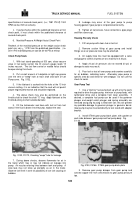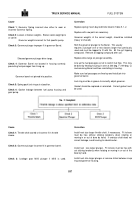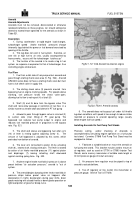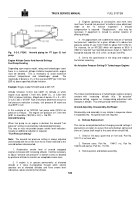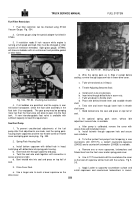TM-5-3805-254-14-P-2 - Page 548 of 894
TRUCK SERVICE MANUAL
FUEL SYSTEM
Fig.
5-2-5, F5245.
Aneroid piping for PT (type G) fuel
pump
Engine Altitude Derate And Aneroid Settings
Fuel Pump Derating
Depending upon engine model, rating and turbocharger used,
there is a maximum altitude limitation beyond which engine
must be derated.
This is necessary to avoid excessive
exhaust
temperatures
and
turbocharger
speed.
The
magnitude of derate is 4% of the sea level BHP per 1000 feet
[305 m] above specified altitude limitation.
Example:
Engine model NTC335 rated at 335 H.P.
Altitude limitation 12,000 feet [3657 m] Altitude at which
engine must operate 17,000 feet, [6181 in] , or 5,000 feet
[1524 in] above limitation. Magnitude of derate 4% x 5 = 20%
or 0.20 x 335 = 67 BHP. Rule of thumb to determine amount of
fuel pressure reduction is simply, fuel pressure @ rated sea
level BHP x 0.20.
In this example of an NTC335, fuel pump code 2312A fuel
pressure is 183 psi.
The engine fuel pressure at 17,000 feet
[6181 ml should be (183(183 x 0.20) = 146 PSI.
Aneroid Derating
When fuel pump on an engine is derated, the aneroid "fuel
pressure" setting is automatically reduced proportionately.
This may or may not provide proper smoke level reduction.
Usually an additional reduction is required.
"Fuel Pressure Setting"
Note:
The aneroid fuel pressure setting is always adjusted
and checked with the air line from the air intake manifold to the
aneroid bellows disconnected.
1.
Acceleration smoke level of aneroid equipped
engines increases with increasing altitude:
It will be necessary
to adjust "aneroid fuel pressure" or bottom screw as dictated
by particular altitude to maintain an acceptable smoke level.
2.
If engine is to operate permanently at elevated
altitude or if some municipalities through which vehicle
operates are at elevated altitudes and have smoke level
ordinances, adjust aneroid to that altitude.
3.
Engines operating at construction and mine sites
must have "aneroid fuel pressure" or bottom screw adjustment
made
at
the
"In
Service
Inspection"
if
altitude
compensation is required.
Readjustment.
also may be
necessary If equipment is moved to another location of
differing altitude.
4.
An approximate rule to determine amount of "aneroid
fuel pressure" reduction for a given altitude is to reduce fuel
pressure setting 3% per 1000 ft [305 ml above 500 ft [152 ml.
For instance, on an NTC335 which will operate at 6000 ft
[1829 m] "aneroid" fuel manifold pressure shown in Table 521
should be reduced 125 x 5.5 x 003 = 20.6 psi [142 kPa].
5.
Set to this specification in the shop and readjust in
the field as necessary.
Air Actuation Pressure Setting Of Turbocharger Engines
The intake manifold pressure of turbocharger engines remains
constant with
increasing
altitude
thus
"air actuation"
pressure setting
requires no
compensating adjustment with
changes in altitude.
This setting should never be altered.
Aneroid Assembly, Disassembly And Repair
Disassembly and assembly is very simple in sequence shown
in exploded view.
No special tools are required.
A.
Bellows Replacement
This can be accomplished without changing aneroid settings if
precautions are taken to assure that same bellows spring and
shims or 2 piece shaft length is the same when reinstall led.
1.
Grind or file away upset end of rivet seal, Part No.
125111 or cut seal wire.
2.
Remove cover, Part No.
114947, nut, Part No.
108074 and washer, Part No.
114754.
3.
Remove piston and bellows assembly.
543
Back to Top

